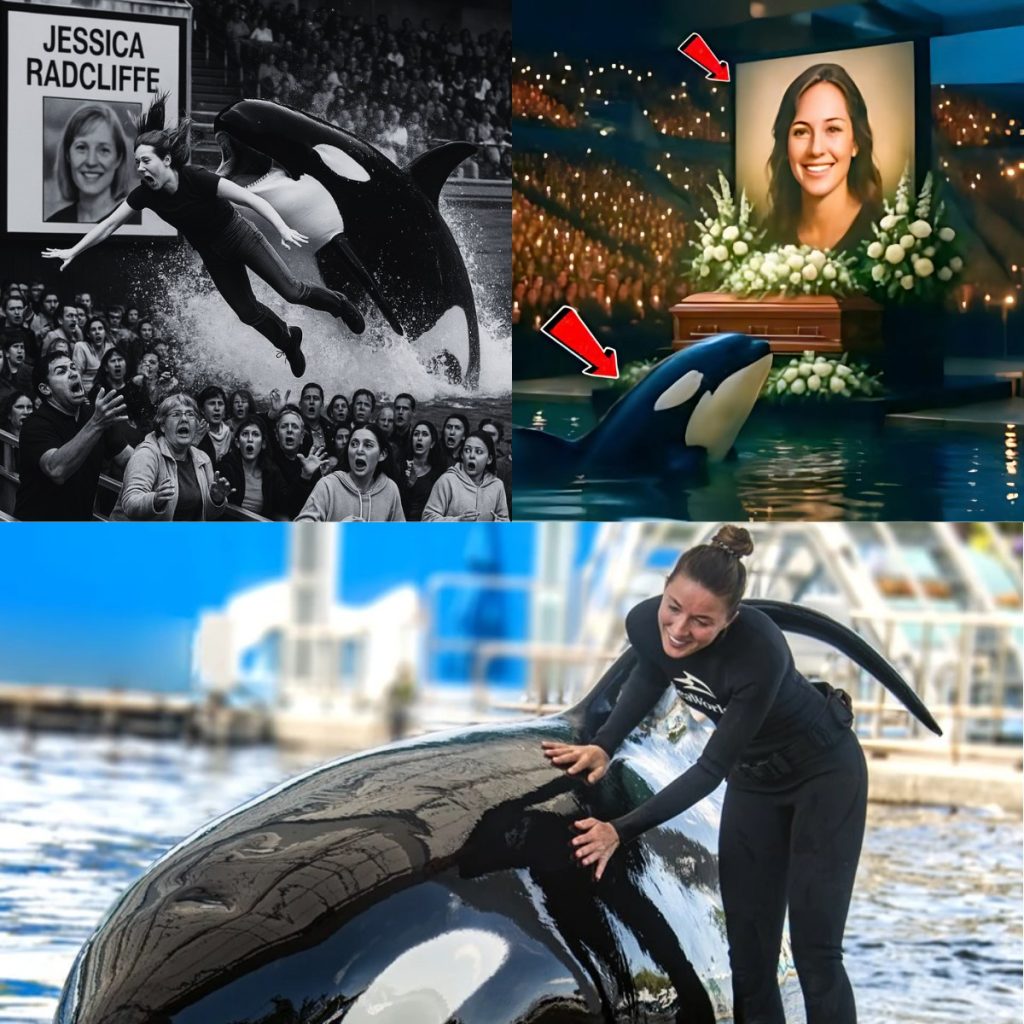
What was meant to be a solemn and tender farewell descended into chaos and terror as mourners gathered to honor the late Jessica Radcliffe, a renowned marine trainer whose life was dedicated to the care of killer whales. The memorial, held at the very aquatic center where she had spent most of her career, was filled with family, friends, colleagues, and supporters who came to pay tribute to her life and legacy. For the opening moments, it unfolded as expected — a moving ceremony of remembrance, with emotional speeches, photographs projected on a large screen, and the presence of the very animals she had trained, standing as a living testament to her work. Yet what began as a heartfelt tribute turned in an instant into a nightmare that no one present will ever forget.
The centerpiece of the memorial was a symbolic routine performed by the killer whale she had worked with for nearly a decade, a creature that had been described by staff as unusually intelligent and deeply bonded with Radcliffe. Trainers had insisted that the performance would be a gentle, choreographed gesture of farewell — a circle in the water, a rise at the pool’s edge, and a splash of tribute that was meant to honor the woman who had once commanded its routines. As the whale surfaced, the crowd applauded softly, some wiping tears as the animal seemed to acknowledge the loss. Among the attendees was Radcliffe’s young daughter, standing close to the edge of the platform where her mother had so often stood. The child was embraced by relatives, shielded but still visible, a living reminder of the trainer’s legacy.
But in a shocking and devastating moment, the whale lunged without warning. With a sudden burst of power, it propelled itself toward the platform, striking the barrier and sending a spray of water over the first rows of the audience. Before anyone could react, the whale’s massive head surged forward and knocked Radcliffe’s daughter from her place. Witnesses described the scene as surreal — the girl hurled into the air, her scream piercing through the stunned silence before she landed in the front rows of the crowd. Gasps and shouts erupted as chaos rippled through the memorial. People scrambled to help, others fled in fear, and security staff rushed toward the platform as trainers screamed commands in desperation, trying to redirect the animal.
The girl, dazed and injured, was quickly carried away by paramedics who had been stationed nearby as a precaution. The crowd, now panicked, surged toward the exits, while others remained frozen in disbelief at what they had just witnessed. What was supposed to be a controlled, symbolic moment of connection between humans and animals had instead turned into a horrifying display of raw, unpredictable power. The memorial had shifted in seconds from a tearful farewell into a scene of pandemonium that no one could have anticipated.
In the aftermath, questions swirled about what triggered the whale’s violent reaction. Marine experts speculated that the animal, already distressed by the loss of its longtime trainer, may have been agitated by the large crowd, the unusual atmosphere, or even the presence of Radcliffe’s daughter near the pool’s edge. Others suggested it was a tragic reminder of the inherent dangers of keeping such powerful creatures in captivity, no matter how well-trained or bonded they may seem. The incident reignited long-standing debates over marine parks and the ethical boundaries of animal performances, debates that Radcliffe herself had been entangled in during her career.
For the family, however, the horror was deeply personal. A moment meant to honor a beloved mother was marred by the very creature she had dedicated her life to training. The image of her daughter being hurled into the crowd has already become a haunting symbol of the unpredictability of human-animal relationships, especially when such relationships are staged before an audience. Friends and colleagues expressed devastation, not only at the renewed trauma inflicted on Radcliffe’s grieving family but also at the cruel irony that the animal she loved most had been the one to disrupt her memorial in such a violent way.
Authorities have since launched an investigation, with officials examining whether safety protocols were adequately enforced and whether the memorial should ever have included the participation of the killer whale. The facility itself faces intense scrutiny, accused by critics of exploiting grief for spectacle and placing both the public and the animals in harm’s way. As the footage from audience cell phones circulates online, public outrage grows, with calls to close the marine park altogether echoing across social media.
In the end, what should have been a dignified celebration of Jessica Radcliffe’s life became a tragic cautionary tale. The killer whale’s sudden lunge transformed grief into horror, leaving scars both physical and emotional that will linger far beyond the day’s events. For those who were present, the memory of that moment will forever overshadow the speeches and tributes, burned into their minds as a terrifying reminder of how quickly control can shatter. And for the world watching, it was one more chapter in the ongoing, uneasy story of human attempts to command the wild, only to be reminded of its untamable force.